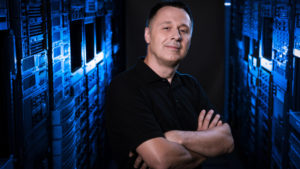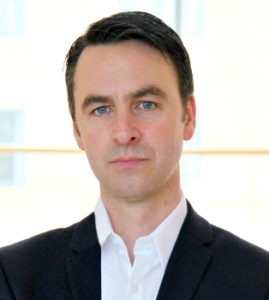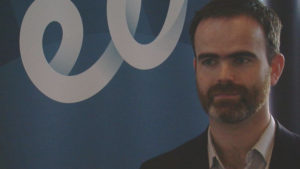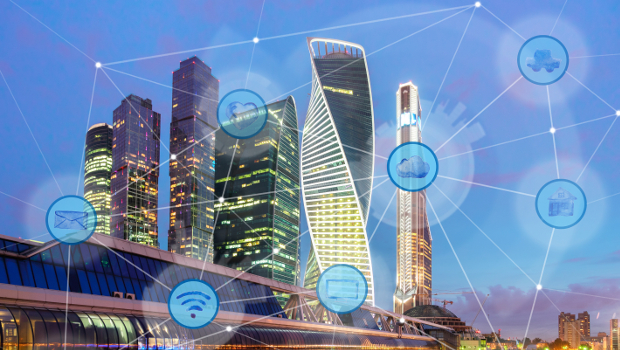Connecting physical devices to the Internet is not an entirely new idea—a humble soft drink dispenser was brought online in 1982 by students at Carnegie Mellon University in Pittsburgh—but recent developments have seen a slew of devices hit the market.
Their utility is somewhat questionable, however, with Wi-Fi-enabled coffee pots an unlikely priority for many. In fact, some consumer applications are maturing, particularly in the form of home automation, but too many Internet of Things (IoT) devices on the market right now are solutions looking for a problem. In addition, security concerns around the potential for hacking, and of spreading distributed denial of service (DDoS) attacks, have come to the fore in the last twelve months.

What’s very, very clear in terms of IoT today, is that predictability and autonomy at the edge are the keys to success—and the only way it will be successful. If it relies on core processing it relies on connectivity and we’re not in a 5G world. We’re not yet at the point where hyperconnectivity is a thing, Richard Bennett, VMware
Industrial IoT
Nonetheless, the technologies underpinning devices such as Amazon’s Echo and Alexa or Google Home are already making waves in less glamorous areas of life: the industrial Internet of Things (IIoT).
The key developments driving IoT adoption are expanded and cheaper connectivity, a massive increase in the availability and scalability of processing power, and developments around both edge computing and machine learning.
Richard Bennett, head of advisory services for the northern Europe, Middle East and Africa region at VMware, says that growth in industry is very strong, but that confusion reigns when it comes to questions around the value of data.
“There’s a quote out there that says, ‘data is the new oil’. Well, maybe data is the new oil [but] the reality is that data is not what is useful; information is what is useful,” he said.
The amount of data being collected and produced has, he says, exploded, but in order to derive useful applications and products it is now necessary to find better ways of processing it.
“We’ve vastly increased the amount of data that has been produced and collected, but without any useful processing. Consider an autonomous vehicle, say a level 2 autonomous car. These things are generating—look at the stats from BMW and Mercedes—gigabits of data every 100 kilometres. If you add that to [the data produced by] Eddie Stobart in the UK or Maersk in Europe… consider that amount of data.”
Specific, not universal
IoT applications now, however, tend toward the particular rather than universal: they seek to solve a specific problem, rather than contribute to and collect from the mass of data swirling around in the world.
VMware has worked with Leeds General Infirmary to track blood packs, which are easily lost in theatre, and the Kuwait National Petroleum Company (KNPC) on predictive maintenance.
“Blood test packs during trauma are valued at £25,000 (€28,000) apiece. They have a short sell by date, too. They were falling behind cabinet, and so on. IoT is about how you contextualise data about physical items.

Real-time connectivity fundamentally changes your business [and] where IoT really takes over is when the business is running hyper-distributed applications across every asset they own, Tom Maher, Asavie
“KNPC, meanwhile, has seen that our approach does two things. it gives them predictability of failure, but it also gave them predictability of the future of fossil fuels,” said Bennett.
This second aspect is something that can provide more utility in other oil operations.
“They’ve been using VMWare technology to measure throughout in the oil pipe, so they can see when a well is delivering less or starting to degrade. If you consider the North Sea or off the coast or Lagos, they now have moveable rigs [and using IoT sensors to monitor throughput] means no longer bringing up dry ore when it is finished. Dry ore damages the rig and takes months to fix.”
Local processing
Bennett said that in many cases, the addition not only of sensors and networking, but considerable processing power on-site remains crucial.
“What’s very, very clear in terms of IoT today, is that predictability and autonomy at the edge are the keys to success—and the only way it will be successful. If it relies on core processing it relies on connectivity and we’re not in a 5G world. We’re not yet at the point where hyperconnectivity is a thing,” he said.
Tom Maher, chief technology officer and co-founder of Asavie, said that the question with the IoT is not one of the ability to connect devices to the Internet, but which devices should be connected.
“We would have started off very much in remote access. The other side of the coin [to that] is what is called the Internet of Things. Within the Internet of Things, we are also interested in the Internet of important things,” he said.
Platform
Asavie has built the PassBridge platform to make it easier for people to connect to each other and everything around them, building on the experience of earlier machine-to-machine (M2M) communication—and key differences between IoT and M2M is the addition of both openness and data.

I think the real killer application is industry business, particularly manufacturing. Manufacturing has some obvious reasons for using IoT and the reasons are basically to reduce downtime, to help maintain all of the expensive legacy plant equipment. It extends them and makes them better in terms of maintenance, but also energy use, Bojan Sneberger, Comtrade Digital Services
“What’s important is what’s important to business,” said Maher.
“When we talk about digitalisation and IoT, fundamentally it’s all about ‘softwareisation’ and what that enables. We’ve been in this for quite a while and we’ve seen things like metering: single use case devices, with a clear return on investment. What we’re beginning to see now, though, is a more fundamental transformation, where businesses are saying everything I have is already a computer.”
This, he says, is beginning to drive a different attitude to what can be done with the IoT, and even what kinds of business models it can support.
“We’re working very closely with the likes of Dell [but] it’s not [just about] a product; it’s an investment in the future of businesses. Real-time connectivity fundamentally changes your business [and] where IoT really takes over is when the business is running hyper-distributed applications across every asset they own.
“There’s a whole load of industries out there who make things: generators, pumps, engines, all kinds of things. It has transformed from a business about making heavy machinery with maybe a computer attached to it, to industries that manufacture things that are controlled by computers,” he said.
IoT hub
Bojan Šneberger, general manager of industry business at Comtrade Digital Services, says that right now Ireland is a key hub for IoT.
“Ireland has a lot of IoT things that are going; many other European nations are quite conservative,” he said.
What happens next, though, is open to question.
“With IoT, we are now in the position where the technology exists; technology meaning sensors, cloud and all sorts. The infrastructure is ready, too. The real problem, or the real issues, today is to recognise the right killer application that will work on top of this technology,” he said.
Šneberger says he questions some of the much-ballyhooed IoT applications.
“Many cities take a ‘smart city’ approach, for example, or we see the connected home approach. I truly doubt that this is a killer application.”
The driving force behind the digitalisation of the physical world is not so much the digitalisation as the nuts and bolts, then.

Customers were used to constant connectivity, mobile phones and so on. What they wanted was someone to help them visualise data, to set rules at the edge and make sure the right data is collected at the right time, for the right reasons, Paull Glynn, Davra
“I think the real killer application is industry business, particularly manufacturing. Manufacturing has some obvious reasons for using IoT and the reasons are basically to reduce downtime, to help maintain all of the expensive legacy plant equipment. It extends them and makes them better in terms of maintenance, but also energy use,” said Šneberger.
Heavy push
Comtrade’s IoT push is then, unsurprisingly, aimed squarely at the heavier side of industry where physicality is not just part of the business, but is the business.
“In Ireland, there are very many windmills, for example. They’re very expensive equipment and they need to be maintained, but in order to maintain it you need to stop it. It also needs to be inspected after lightning strikes. We developed a system that detects how strongly it was hit by lighting. This not only helps to stop it falling down, but also with maintenance.”
Šneberger says that the next likely development will be the creation of new business models around maintenance, where outside companies can be hired to take ownership of maintenance itself.
“Today, with IoT technology it is [already] possible to take ownership of the downtime. There are companies that take care of maintenance of the machine. Think about elevators, or ship engines. A ship engine is a very complex system. Thee operator today owns the engine, but there are business models where a company could guarantee it,” he said.
IoT lab
One vote of confidence in Ireland as a centre of expertise in the IoT is Dell’s location of its IoT lab in Limerick. Marc Flanagan, Europe, Middle East and Africa director for IoT and embedded at Dell, says the IoT lab, which opened two years ago, is not just about blue sky research. It is developing real products.
“A big part of it is working with businesses to help grow their idea,” he said.
The concept of the lab was conceived in the US by Jason Shepherd and Andy Rhodes, who went to Michael Dell with the idea.
“The decision was made to get into the IoT at the edge and develop IoT gateways and industrial computing. This is obviously very different from doing something like desktop PCs or laptops,” said Flanagan.
“It’s information technology meets operations technology,” he said.

Adoption of IoT technologies has more than doubled since we launched the first report in 2013. Today, organisations are using IoT to create completely new services and transform their businesses. Two-thirds of companies that have adopted IoT say that it’s already mission-critical. And nearly all of them have already seen a return on their investment, Debbie Power, Vodafone
Flanagan said Dell did not want to simply develop products so much as it wanted to develop an ecosystem of partners who each offered different solutions.
“There’s no one company out there with a one-size-fits-all, end-to-end solution,” he said.
The Limerick lab is Dell’s main IoT hub for Europe, Middle East and Africa, and it is already producing results, says Flanagan.
Dell and Intel
“We developed it in conjunction with Intel, and by bringing the IoT lab on board it means we can showcase it to customers who are visiting other parts of the Solutions Centre. Also, from a Solutions Centre point of view, we can also help customers do proof of concept. We’ve done some recently with our CCTV partners, who are looking at putting our technology right at the edge where the cameras are, so that they can to intelligent processing right there at the edge
“We also have things like manufacturing, and IoT has a large role to play in predictive maintenance. In the manufacturing space one of our key partners worldwide, Actionpoint, is also based in Limerick. In fact, they were doing IoT before IoT was a buzzword.”
Edge computing has become a vital part of the IoT, as connectivity is not always available. Nonetheless, without some form of connectivity, the IoT simply would not exist.
Edge capability
Damian Duffy, eir’s business head of IoT, says that the company has recently launched a cellular connectivity package for IoT that allows products to be developed, tested and deployed.
“What’s unique about it is that we can scale,” he said.
The idea is that the smallest start-up can begin with eir, and eir will grow with it.
“The minimum is one sim card on a 30 day contract. If you’re a large company and you have a lot of resources you will have any number of global players tripping over themselves to get your business, but if you’re a start-up or even a company working on a project it can be quite difficult to get connectivity.”
The company’s research found that many start-ups, and even some production environments, were forced to use pre-paid SIMs, with all of the management complexity that implied.
“We can go right up to hundreds or thousands of SIMs, as required,” said Duffy.
Also on offer from eir is connectivity via a low powered network in the form of SigFox, offers to wrap other services around it, such as project management, or other forms of concentricity to complement it.
“We [also] have a tracking solution called SticknTrack and industrial-grade, low cost routers, modems and so on, allowing vending machines, digital advertising screens and so on to be connected,” he said.

Our connectivity package for IoT that allows products to be developed, tested and deployed. What’s unique about it is that we can scale. The idea is that the smallest start-up can begin with eir, and eir will grow with it, Damian Duffy, eir Business
Transport and retail
“The areas that I’m seeing lots happening in today are transport—transport is way ahead of everyone; it’s a form of predictive maintenance—and security, where it’s a real practical use: alarms using SIM cards, connected CCTV and so on.
“Retail is also a big one,” he said, “point-of-sale devices, digital advertising, footfall counting and so on. On the logistics side it’s drifting into mobility more and more.”
Paul Glynn, chief executive of Davra Networks, says that the key to the IoT’s success is that it ceases to exist.
“The reality is IoT, like e-commerce before it, is different in every industry. I would not suggest to anyone that the IoT is a market onto itself,” he said.
Which is not to say that the IoT is not real, simply that it needs to be considered in terms of use case at all times. This is where the useful products and services will be delivered.
“We’re a six year old company, which makes us the old guy of IoT in Ireland,” said Glynn. “Our background is networking [and] our view was that the networking world was changing. people were looking to connect things that were never connected before: busses and trucks and trains, ATMs and vending machines.”
The difference is, with IoT, customers had a different view of what networking was for.
“They were used to constant connectivity, mobile phones and so on. What they wanted was someone to help them visualise data, to set rules at the edge and make sure the right data is collected at the right time, for the right reasons,” he said.
One of Davra’s projects is working with the UK’s Network Rail to monitor railway line vibration, using a mixture of edge computing and live connectivity depending on the situation.
“Our fog stack is sitting on the box attached to the [rail] lines and it sends data back once a day, but if the line vibrates too much we create an alert. There’s a rule for that, but that rule, the amount of acceptable vibration, changes depending on the temperate. We make that decision at the edge instead of wasting bandwidth and CPU cycles in the cloud.
“Our fog stack also connects to the signal box and changes the nature of the action depending on whether or not there is a train. It can contact the helpdesk, or it can tell the signal box to stop an oncoming train, slow it down or move it to another line. It a train is speeding toward a problem you can’t send it to a helpdesk. That’s the benefit of fog: if you have something at the edge, you can make the decision at the edge,” said Glynn.
Davra’s solutions, then, are driven by a clear understanding of the goal. The problem with IoT is, says Glynn, one common to many IT projects: muddled reasoning and unclear goals.
“Forbes claims 66% of IoT projects never get to proof of concept, and of those that do many don’t get any further,” he said. “By writing about the IoT the wrong way, as many have, we hear about the art of the possible. People can get ten years ahead of themselves instead of thinking, ‘what is my problem and how can I solve it’.”
IoT barometer
Each year, telecoms company Vodafone publishes its IoT barometer, measuring uptake and attitudes when it comes to the industrial IoT, and the recently published 2017–8 report, provided a particularly interesting snapshot.
For instance, of all of the companies that use IoT technologies, 67% report having come to rely on it as mission critical. In addition, once they get involved with IoT technologies more will follow: over four-fifths of IoT adopters have increased their use of IoT. Overall adoption has risen from 12%cent in 2013 to 29% in 2017. Transport and logistics (19% to 27%) and retail (20% to 26%) have shown the largest year-on-year gains from 2016.
Vodafone’s interest in IoT, naturally, is in the connectivity business, and is engaged with data transmission from SIM-integrated devices.
Debbie Power, IoT solutions sales manager at Vodafone, says there is a productivity boost to be had.
“For example, an agricultural company could achieve higher yields, increase productivity and lower costs by using solar-powered crop-watering equipment with embedded wireless devices linked to data from satellites and ground sensors, to take into account crop conditions, temperatures and weather conditions in order to adjust the way each crop or field is watered,” she said.
One Irish start-up has made the most of the agriculture field: MooCall, which uses an intelligent sensor to communicate bovine health information. MooCall used Vodafone connectivity, and has already been rolled out in several countries.
According to Power, the scaled of adoption depends on industry and sector.
“Adoption of IoT technologies has more than doubled since we launched the first report in 2013. Today, organisations are using IoT to create completely new services and transform their businesses. Two-thirds of companies that have adopted IoT say that it’s already mission-critical. And nearly all of them have already seen a return on their investment.
“We are seeing adoption across a number of sectors, but some are consuming more readily than others. The most active verticals include utilities (e.g. electricity, water, gas and telecoms), automotive, smart city, logistics and healthcare,” she said.









Subscribers 0
Fans 0
Followers 0
Followers